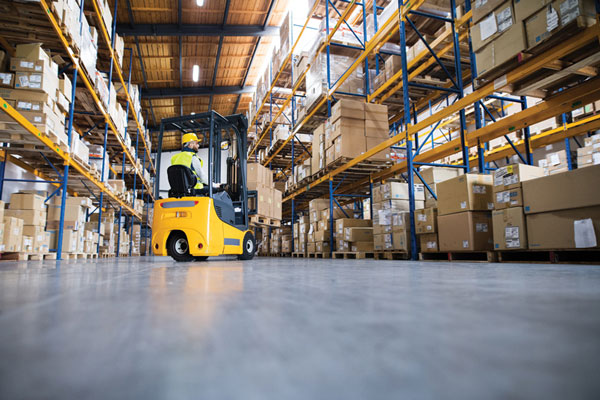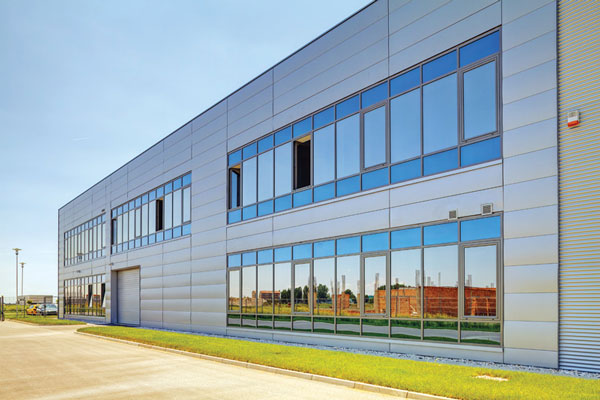Amazon Could Provide a Peek at Industrial’s Post-COVID Future

The e-commerce giant understands how to connect products and consumers.
Commerce was changing before the outbreak of COVID-19, from the exponential trajectory of e-commerce, to the growth in consumer demand for more immediate goods, to the rise of urban industrial development to fulfill last-mile needs.
The unknowns of this novel virus have accelerated that change to a tipping point. The structures of commerce, and the development that supports it, may be altered for good. This crisis is proving the necessity of a resilient supply chain.

Many large retailers have struggled to meet a surge in online orders as they simultaneously adapt to COVID-19’s effects on the workforce. Getty Images
What will new commerce look like and how will industrial development respond to support it? Some answers may lie in examining the world’s largest commercial enterprise — Amazon. Through the lens of Amazon’s success, there is a path forward for industrial development to be part of the resilient supply chain.
First, the answer is far more complicated than consumers buying more goods online.
It involves a better integrated and more resilient form of commerce. Development that supports this new commerce will become more horizontally integrated between uses. The value of more localized goods, and a stronger market mechanism that connects to the consumer at the beginning and end of the supply chain, will replace the demand for immediate goods. Innovative infrastructure that is both digital and physical, and increasingly local, will help avoid reliance on a global supply chain.
Marketplace Mechanism
What began as an online retailer selling a single product has morphed into an online marketplace selling everything from clothing to groceries. Amazon generated $280.52 billion in net sales in 2019, up 20.5% from the previous year. And since the coronavirus crisis began, consumer spending at the e-commerce giant is up 35% compared to the same period last year according to Facteus, a firm that analyzes daily payment card transactions. Additionally, while the U.S. is facing staggering unemployment numbers, Amazon is on a major hiring spree. The company announced in April that it is seeking to hire 75,000 additional workers after it brought on more than 100,000 positions in March.
Amazon’s entry into more markets has created a network effect: if everything is available on Amazon, consumers are more likely to buy there, making sellers more likely to sell there.

The coronavirus pandemic has shown the importance of rethinking warehouses that store goods outside the suburban and urban landscape, according to Ed Klimek, a partner with KSS Architects. Getty Images
Harvard Business School Professor Sunil Gupta has noted that “in today’s world, competitive advantage comes from connecting products and connecting consumers.” This is one of the most crucial drivers of Amazon’s growth — its continuous ability to bring customers back to purchase new products and services on Amazon.
Industrial development must implement its own marketplace mechanism to better connect consumers with products and services, and to help eliminate friction from horizontal integration as new networks are created. This will mean rethinking warehouses that store goods outside the suburban and urban landscape. Instead, development will favor true mixed-use developments where ideas are generated, companies collaborate, and the newest products are created and distributed at a rapid pace to a continuously returning consumer base. As opposed to traditional industrial development, these will be mixed-use marketplaces consumers will visit, where the integrated possibilities of commerce are spread out before their eyes.
Customer Proximity
Amazon takes the adage “the customer is always right” a step further. The company aims to improve customer experience at every opportunity. Intense consumer focus drives the company to adapt its supply chain in directions that at first seem disparate, like an online retailer producing movies, but then seem like a natural progression when seen through the lens of relentless dedication to customer satisfaction.
Commerce has grown accustomed to a completely globalized market. Yet, early on in the COVID-19 crisis, that highly interconnected supply chain collapsed, throwing a wrench in the ability to meet consumer demand and exposing an important weakness. The collapse underscored a critical element of the new commerce paradigm: being close to the customer matters. Close proximity to the customer means that things like movie studios belong in industrial development. Industrial development must have the ability to both produce and distribute in ways that are driven by the values and complexities of an increasingly localized market, even as it interacts with the remaining global supply chain. A client recently captured this well as he said, “You can get a whole lot more product out there if you can simply get components rather than rely on waiting for completed assemblies.”
Infrastructure Agility
According to early Amazon employees, founder and CEO Jeff Bezos had clear ambitions for expansion from the company’s beginnings. Despite not being profitable for its first 14 years, Bezos persuaded investors that Amazon was building an infrastructure that would enable it to gain scale, customers and business. He promised long-term profits and increased profit share. He eventually delivered, and then some.
Today, Amazon has 1,137 active facilities around the world, including 519 in the U.S., according to research from MWPVL International, a specialized supply chain, logistics and distribution consulting firm. The astounding evolution of Amazon has brought Bezos’ vision to fruition, and it is all made possible by the groundwork laid in the company’s early years.
The infrastructure that will support new integrated development will no longer have as its sole focus the 40-foot box of global trade. This typology will, of course, remain, but infrastructure will count on connection and connectivity through digital and physical means. For example, integrated industrial development will rely on a robust network that supports multisized vehicles working in multiple modes with increasing sustainability and decreasing friction. Industrial clients will begin to control an increasingly large portion of local transportation infrastructure, while still relying on externally controlled transportation infrastructure. It is possible that in the post COVID-19 environment we may have lost some of the obsession with same-day or within-the-hour delivery. But, regardless, we will expect a localized system of delivery that is better integrated within our daily lives.
As this crisis is still ongoing, we don’t yet know the full extent of its impact and how we will need to react. However, it has clearly demonstrated the need and value of more integrated communities. We have blurred the lines between where we live and where we work, exposed the weaknesses of an overly global market, and demonstrated the value of local sufficiency and expectation. Development that recognizes this phenomenon, in ways that are frictionless, will add the greatest value in a post COVID-19 world.
Ed Klimek, AIA, NCARB, is a partner with KSS Architects.
Supply Chains Adapt to New DemandsLong-term trends toward globally integrated supply chains, just-in-time logistics and rapid deliveries by online retailers have driven the pace and shape of demand for warehouse and distribution centers for the past decade. However, by disrupting supply chains around the world, the coronavirus outbreak has led some to question whether these trends are sustainable. The virus has posed a challenge to every link in global supply chains, from factories and ports in China to manufacturers, warehouses, grocery stores and medical providers in the U.S. 
Chris Caplice Chris Caplice, Ph.D., is the executive director of the MIT Center for Transportation & Logistics and the founder and director of the MIT FreightLab, which is currently examining a range of freight-related research topics, including the effects of natural disasters on U.S. truckloads, global ocean transportation reliability and freight network optimization. Development magazine spoke with Caplice to explore how supply chains are adapting to the coronavirus outbreak. Effects on Global Supply ChainsAccording to Caplice, seasonality helped to dampen some of the outbreak’s initial effects on global supply chains. The beginning of extensive measures to contain the outbreak in China coincided with the Chinese New Year. Importers in the U.S. had already prepared for disruptions associated with the holiday by increasing their stockpiles. Many had also previously increased inventories before U.S. tariffs on Chinese goods took effect in 2019. These stockpiles helped to delay the effects of a supply shock to U.S. retailers and manufacturers. “Essentially the slowdown in February was almost an extension of the Chinese New Year,” he said. “February is not a big demand month, so there was a lag.” Now that Chinese manufacturing and exports are getting back up to speed, U.S. ports face the challenge of processing a surge of Chinese imports arriving on container ships. Caplice notes that U.S. ports are highly automated, but social distancing measures to contain the coronavirus could slow down their ability to process cargo. Some importers are responding to delays in shipping goods from China by shifting orders to air freight. Shortages of medical supplies and slowdowns in manufacturing and construction as ports wait for shipments from China have prompted some observers to question whether it is time to rethink globally integrated supply chains. Although Caplice does not believe that U.S. firms will fully divest from Chinese manufacturing, he notes that the outbreak may reveal a greater need for dual-sourced supply chains and less reliance on China. China’s reaction to the outbreak may also Chris Caplice lead to a long-term reallocation of the country’s logistics capacity, with an increased emphasis on serving domestic markets instead of exports. Disruptions associated with the outbreak have also prompted some, like U.S. Trade Advisor Peter Navarro, to advocate for relocating more productive capacity to the U.S., especially for medical supplies and other strategically important goods. Caplice believes that there may be some reshoring of supply chains where labor costs make up a small portion of a good’s total cost or where it is important to have very short supply lines between production and the market. However, he notes that past predictions of an impending shift toward reshoring have yet to be realized. “We’ve been saying that for 10 years now, and I think it makes sense because our cost of energy is lower now because of all the fracking and the availability there,” he said. “I just haven’t seen it in practice.” Shifts in Consumer DemandSocial distancing and other measures to contain the coronavirus are also affecting demand patterns and supply chains within the U.S. Caplice observes that manufacturing has slowed significantly, particularly for expensive consumer durables that now face limited demand. Retailers and restaurants have also experienced a significant drop in business, and many were forced by state or local governments to close their doors to customers. On the other hand, grocers have struggled to meet a surge in demand for food, cleaning and hygiene products. Caplice observes that this surge results in part from consumer hoarding behavior, but also reflects a response to restaurant closures. “You’re not able to go to restaurants so more people are eating at home, so you’re seeing more volume going through groceries,” he said. Caplice notes that these shifts in consumer demand are also reflected in supply chains. For example, Tyson has repackaged a significant share of the chicken it would normally distribute to restaurants for shipments to grocers. Overall, short-term demand for distribution centers has grown as grocers and e-commerce retailers try to catch up to spikes in consumer demand. The Wall Street Journal has also reported a surge in one-way truck routes. This is happening because retailers are demanding more shipments of consumer staples to areas where truckers are unable to find outbound freight orders that they might normally be able to book for non-staple consumer goods. Caplice sees the increase in oneway trucking flows as a sign that the market is responding correctly to an increase in demand. While carriers generally prefer to avoid one-way trips, a surge in demand can increase spot rates enough that they can profit from a trip even if they are unable to carry a load on their return. Long-Term Effects on U.S. Supply ChainsCaplice believes that just-in-time logistics has helped supply chains grow more flexible and responsive to market demand, and it is now allowing them to respond more effectively to disruptions associated with the outbreak by moving goods more rapidly. Caplice notes that although supply chains in earlier years relied more on inventories for redundancies, they were less responsive to changing market conditions, and larger inventories likely would have been insufficient to make up for disruptions associated with the outbreak. There are also downsides to stockpiling. With larger inventories, it is easier for unsold or unused products to become outdated or perish. As much as grocers have at least temporarily adapted their inventory practices to keep up with demand, online retailers that once offered one-day delivery are now seeing those orders delayed. Large retailers have struggled to meet a surge in online orders as they simultaneously adapt to the virus’ effects on the workforce. However, Caplice observes that supply chains organized around one-day delivery are not necessarily more fragile than other supply chains; they are just more expensive to operate. “That inventory is getting pushed closer to population centers because the only way you can provide one-day is to have more of it closer,” he said. “There aren’t Hyperloop tubes or anything to go great distances that fast.” Caplice does not believe the outbreak will significantly affect the long-term trend favoring distribution centers that are located closer to the populations they serve. However, he notes that rapid changes in demand may encourage large retailers and distributors to take advantage of short-term warehouse space offered by on-demand providers like Flexe. Although the outbreak is unlikely to have a long-term effect on warehouse location decisions, Caplice believes it may lead to a broader adoption of automation within warehouses. “You don’t have to do social distancing for robots, and they don’t have absenteeism,” he said. Automated operations within a warehouse can be ramped up or down despite a pandemic or other disruption to the labor supply. Shawn Moura, Ph.D., is the director of research for NAIOP. |
Demand for Cold Storage Heats Up During Shutdowns
Demand for public refrigerated warehouse companies and online grocers surged as consumers sheltered in place, according to an April report by CBRE, “COVID-19 Impact on the Food Industry & Implications for Industrial Real Estate.” According to the report, COVID-19 will change the cold-storage sector in five critical ways:
- E-commerce grocery shopping will become more widely adopted, creating greater demand for cold storage capacity. However, the volume of perishable orders will need to grow to have a significant impact on cold-storage real estate decisions. In general, there is a recent consumption trend toward food that drives demand for temperature-controlled space, like frozen meat and processed poultry. Until recently, consumers were not ordering a lot of perishables online, but that likely will change in a post-COVID-19 environment.
- Since e-commerce is typically fulfilled by local grocery stores, retail footprints will include more storage and fulfillment space. As online orders rise, there will be a blending of retail and industrial space, as well as a greater need for infill temperature-controlled facilities close to consumers. Space requirements will vary among food retailers, but additional modern space likely will be needed considering that the average age of cold storage warehouses is 34 years.
- Restaurants may see a significant shift in dining formats with less dine-in options and more delivery or take-out that would require cold-storage capacity. Foodservice companies that supply restaurants may look to second-generation cold-storage space as a cost advantage in a limited dining environment.
- There will be further consolidation among major public refrigerated warehouse companies to gain more control over the cold-storage footprint in the U.S. This will lead to specialized development in major metros where large cold-storage operators will partner with developers to strategically build a network close to population clusters.
- Automation will increase in cold-storage facilities to efficiently fulfill orders and make up for a shortage of workers willing to work in the extreme conditions of these facilities. This will prompt higher-density, greater-height and smaller-footprint buildouts that will be required for around-the-clock operations.
Ron Derven is a contributing editor for Development magazine.






